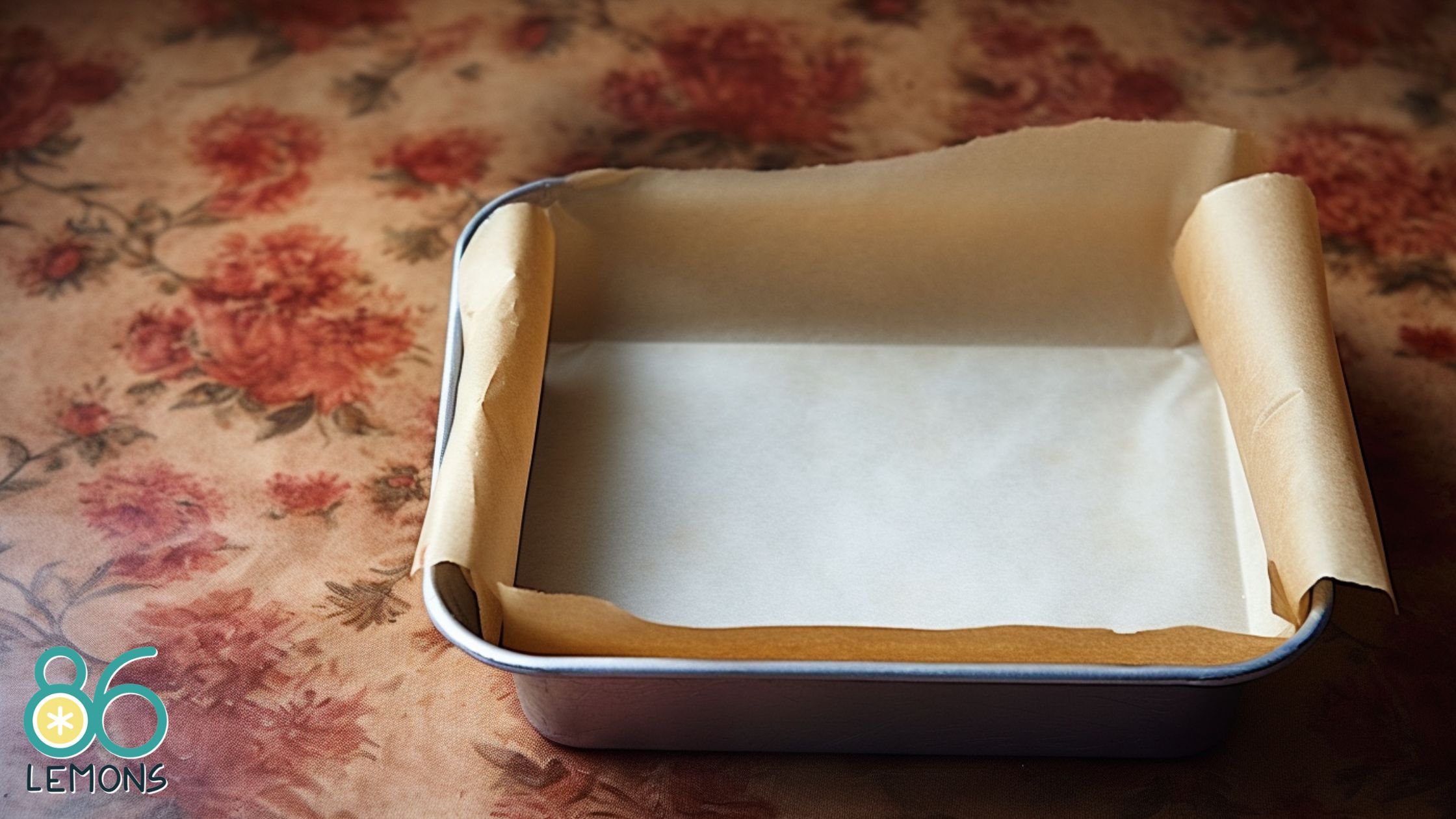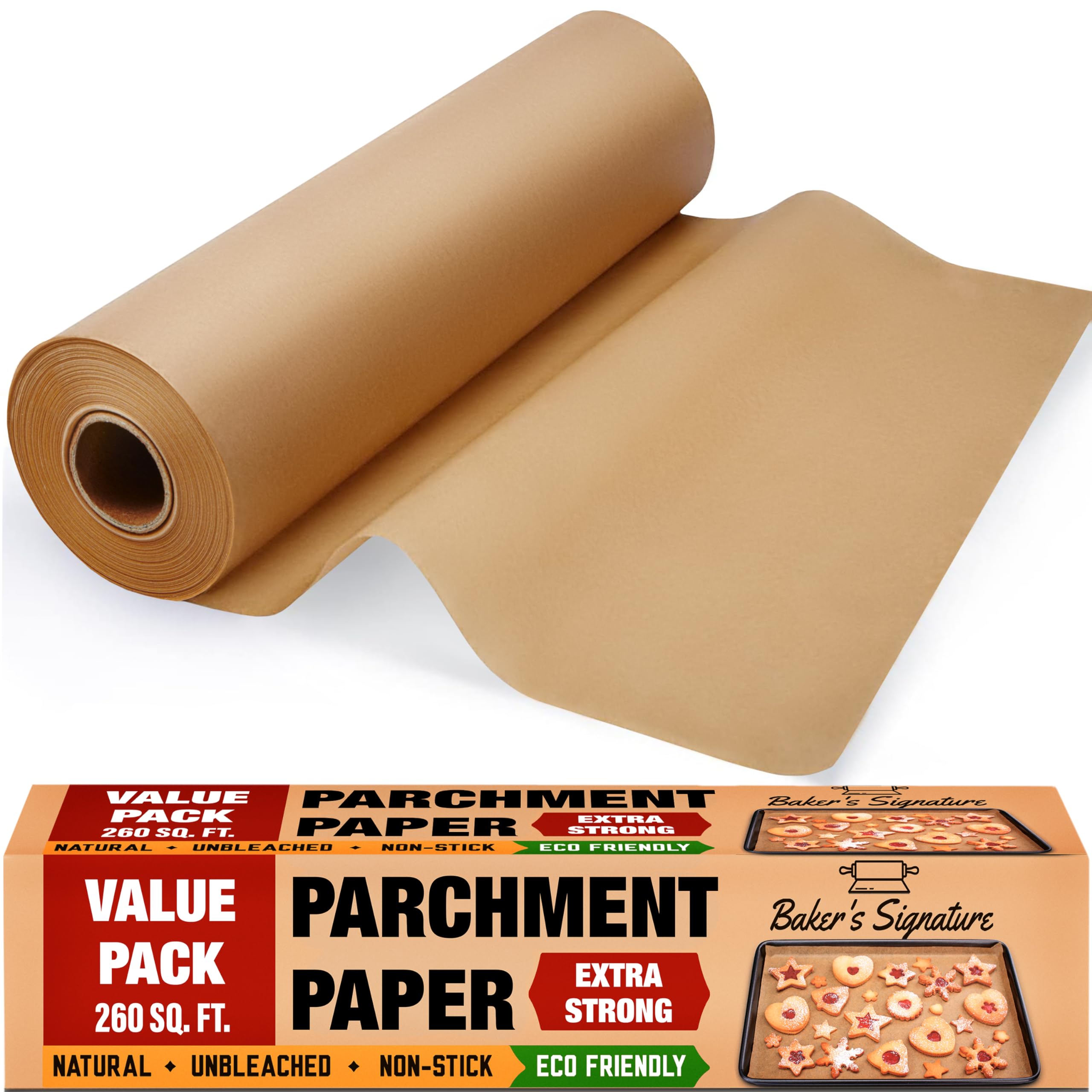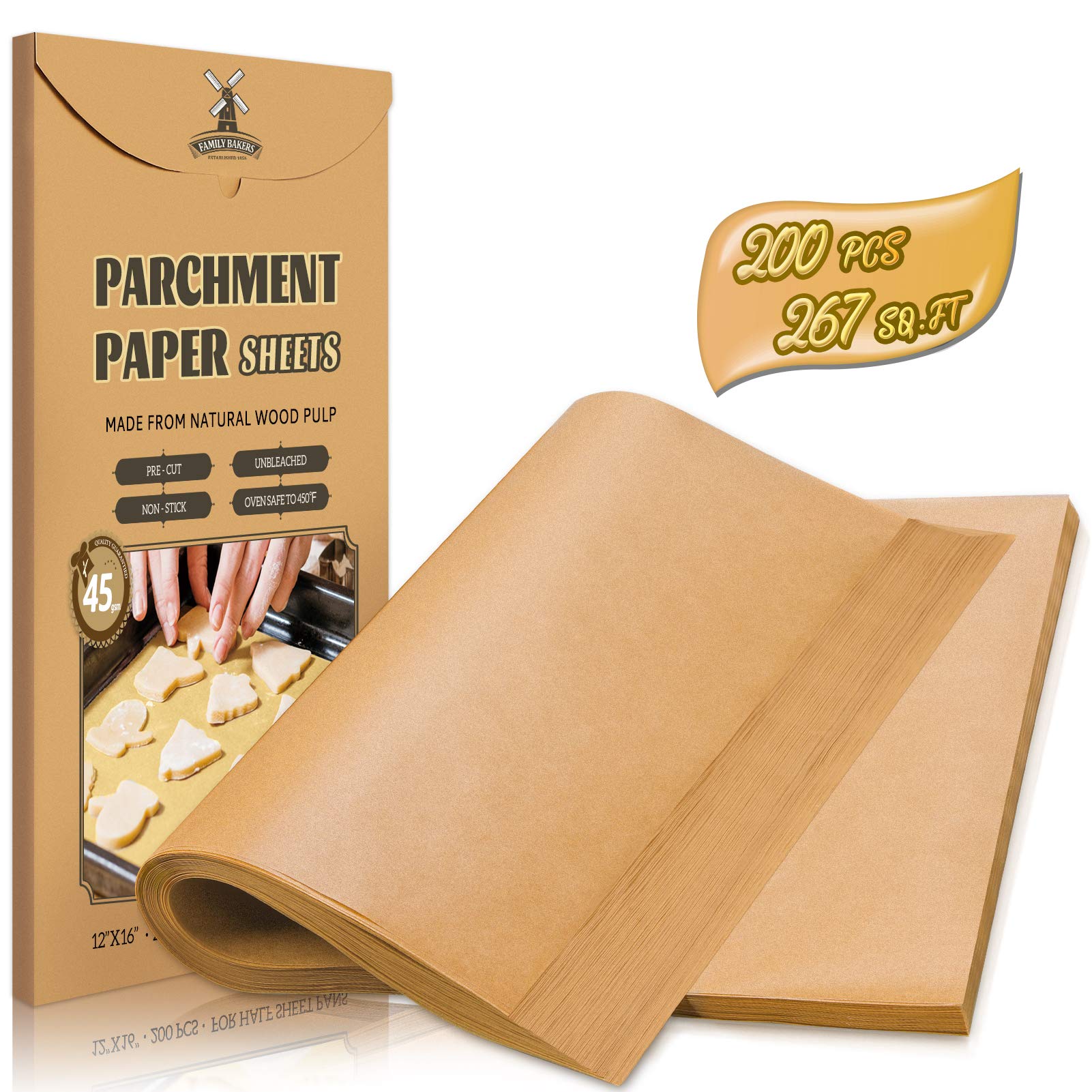When it comes to baking, whether I’m rolling out a pie crust or lining a cake pan, parchment paper is my go-to accessory in the kitchen. It’s not just about keeping pans clean; parchment paper also helps distribute heat evenly and prevent sticking. The beauty of this product is in its simplicity and multifunctionality.
There’s a lot to consider when picking out the best parchment paper for baking. I look for a parchment that can withstand high temperatures without curling or burning, which is essential for consistent baking results.
It comes in rolls, sheets, and sometimes even as pre-cut circles to fit standard cake pans. Thickness and quality can vary, with professional-grade options offering more durability and a better non-stick surface for your 9 x 13 baking pans.
The key features I watch include non-toxic materials and whether the paper is compostable since I like to minimize my environmental footprint while cooking and baking. Size and shape are important, too – I want to be sure the parchment fits my pans without too much excess or waste.
After extensive testing and tasting, I’ve narrowed down my favorites to help you take the guesswork out of selecting the perfect parchment paper that will suit all your baking needs.
Best Parchment Paper for Baking
My top picks for parchment paper reflect my commitment to cruelty-free baking and are perfect for all your plant-based recipes. Let’s dive into the list of the best parchment paper that’ll keep your treats from sticking without hurting our planet.
Hiware Parchment Paper Roll
This parchment paper is a game-changer in the kitchen for baking and cooking with its durability and ease of use.
Pros
- Comes with a cutter for custom sizing
- Thicker and stronger material
- Safe for ovens and microwaves up to 450℉
Cons
- Heavier than some alternatives
- May emit an odor during use
- Can be too slippery for certain recipes
Having just unrolled some of the Hiware Parchment Paper to line my baking tray, I noticed immediately how sturdy it felt. It’s thicker than I’ve typically used. Moreover, the natural, unbleached aspect is reassuring.
Thanks to the built-in cutter, the roll is generously sized, and I love that I can cut pieces to whatever length I need. This feature has reduced my time fiddling with scissors and eyeballing sizes, making my prep work much smoother.
Clean-up is much quicker now, as nothing clings to the baking sheet. The only hitch I’ve found is that the paper can be so slick that it can slide around a bit if I’m not careful when placing my food on it.
Baker’s Parchment
If you’re into baking, this Baker’s Signature parchment paper is a game-changer for its ease of use and non-stick properties.
Pros
- The cutter on the box is accurate and super handy
- It withstands high heat without any issues, making it perfect for a variety of recipes
- Health-conscious and eco-friendly, with 100% natural wood pulp
Cons
- The roll is quite large, maybe tricky to store if you’re short on space
- The unbleached color may not be to everyone’s aesthetic liking
- A bit pricier compared to lower-quality options
Recently, I put this unbleached parchment paper to the test, and I must admit, the hype is justified. Its durable thickness means I can slide my veggie pizzas and rustic breads right out of the oven without any sticking.
I appreciate the brand’s commitment to health by avoiding harmful chemicals. Knowing I’m using a product that’s safe for me and kind to the environment adds a comforting touch to my baking endeavors.
Now, about the smart packaging—with the cutter, I’m getting the exact amount needed every time; no more awkwardly torn pieces or waste. As someone who bakes frequently, this roll is proving to be quite the long-lasting companion in my kitchen.
Hiware Parchment Sheets
I just used these parchment sheets for baking, and I must say, they are a game-changer, especially if you love simplicity and efficiency in the kitchen.
Pros
- The thickness provides durability, no tears or breaks when handling baked goods.
- Precut size is a time-saver and fits perfectly on my half sheet pans.
- Made from natural materials, these sheets are non-toxic and oven safe, aligning with my health-conscious values.
Cons
- Since they’re pre-cut, flexibility for custom sizes is limited.
- The box dispenser could be sturdier; it gets a bit flimsy with regular use.
- May not fit all baking sheets perfectly, folding the edges might be necessary at times.
My first impression of these Hiware Parchment Sheets was how neatly they lay flat, starkly contrasted against my past frustrations with curling edges from rolls. I slid out a sheet and had it fit onto the tray for seamless cookie baking.
The quality genuinely impressed me. In the past, thinner parchment would sometimes tear when I was lifting out my sourdough loaves, but not with these—they held up brilliantly.
They’re unbleached and eco-friendlier than other options, which is a big plus. I’ve used these sheets in my conventional oven and air fryer with no issues and even sandwiched them between veggie burger patties before freezing to prevent stickiness.
SMARTAKE Parchment Sheets
If you’re in the market for hassle-free baking, these SMARTAKE parchment sheets are a total game-changer due to their convenience and quality.
Pros
- Eliminates the need to cut and fit parchment, saving time
- Non-stick surface releases food effortlessly
- Resists high temperatures up to 450°F without scorching or affecting taste
Cons
- Slightly pricier than roll parchment
- May not fit all pan sizes perfectly
- Box storage requires extra space in the kitchen
I recently switched to using these pre-cut parchment paper sheets, and honestly, it’s been a revelation. These sheets fit perfectly on my baking trays, laying flat every time.
Even with sticky, plant-based ingredients, I haven’t had any issues with food adhering to the baking sheet. Cookies and veggie patties slide right off without oil, making it easier to keep my baking healthy and mess-free.
The sheets can stand up to the heat, too. I’ve cranked my oven up to 450°F, and these parchment sheets handle it like a champ. You do need to make some small adjustments if you have an unconventional pan size.
Katbite Heavy Duty Parchment Sheets
I’d confidently recommend these parchment sheets for anyone looking to streamline their baking process with a high-quality, convenient option.
Pros
- Pre-cut size saves time and hassle
- Non-toxic and safe for food contact
- Durable and thick, reducing chances of tearing
Cons
- Box storage may be bulky for some kitchens
- Sheets may not fit all pan sizes
- At higher quantities, cost may be a consideration
The Katbite parchment sheets are a trusted sidekick in the kitchen. Their pre-cut dimension perfectly aligned with my baking sheets and I immediately noticed the durable feel. They’re thick and resist tearing, a common annoyance I’ve faced with lesser brands.
The non-stick surface made for a quick release of my vegan peanut butter cookies. What’s more, the environmental part of me appreciated their non-toxic, wood pulp construction — no icky chemicals leaching onto my food.
Given that these are heavy-duty, I rest easy knowing that the high oven temps won’t faze them. And since they lay flat immediately, I’m not stuck peeling curled edges off the pan.
Baker’s Signature Parchment Sheets
I’d recommend Baker’s Signature Parchment Sheets for anyone seeking a hassle-free baking experience with a quality, non-toxic product.
Pros
- Pre-cut size provides convenience and ease of use.
- Can withstand high temperatures without curling or burning.
- Made from unbleached, silicone-coated wood pulp, ensuring non-toxic safety.
Cons
- May tear when cutting baked goods on it.
- Slightly off in size for some specific pans.
- Individual sheets mean more packaging material.
I just pulled a batch of vegan cookies from the oven using these parchment sheets, and I was impressed by how evenly they baked. The unbleached, pre-cut sheets made everything easy – no cutting, no sticking, and certainly no concern for chemical additives.
Having these sheets on hand has upped my baking game. They’re greaseproof and waterproof, money savers since I no longer need to spray my trays with oil. Removing the baked goods was a breeze as they slid right off the paper.
I’ve used them to wrap vegan sandwiches and snacks, finding it keeps them fresh without the worries of them sticking to the paper. The compact box they come in is a space saver and keeps the sheets perfectly flat, ready for my next baking adventure.
READ NEXT: Best Vegan Baking Cookbook: Sweet Delights & Healthy Treats of 2024
Buying Guide
Factors to Consider
When I’m choosing parchment paper for baking, there are a few key factors I always look out for:
Thickness: A good parchment paper should be thick enough to prevent tearing but not so thick that it affects heat distribution. The ideal thickness usually ranges from 35 to 60 GSM (grams per square meter).
Non-Stick Qualities: The paper should have a reliable non-stick surface to prevent baked goods from sticking, meaning no extra greasing is necessary. This feature is essential for quick and easy clean-up.
Heat Resistance: It’s crucial that the parchment paper can withstand standard baking temperatures (up to 425°F or 220°C). I always check the maximum heat resistance to ensure it won’t burn or become brittle in the oven.
Cut and Size: Preferences vary, but I lean towards pre-cut sheets that fit my pans or a roll that can be easily trimmed to size. This saves me time and helps reduce waste.
Environmental Impact: As an environmentally conscious baker, I look for parchment paper that is compostable or recyclable. It’s important to me that my baking habits do not negatively impact the planet.
Safety: I make sure the paper is food-safe and does not contain any harmful chemicals like BPA, chlorine, or heavy metals.
Comparison Table:
| Feature | Why It Matters |
|---|---|
| Thickness | Prevents tearing, improves durability |
| Non-Stick Quality | Ensures easy release of baked goods |
| Heat Resistance | Allows for use in various baking temperatures |
| Cut and Size | Saves time, suits different pans, reduces waste |
| Environmental Impact | Aligns with eco-friendly practices |
| Safety | Protects my health and food quality |
I focus on these features to make an informed decision and choose the best parchment paper to enhance my baking experience.
Frequently Asked Questions
In exploring the world of baking, I’ve come across some common questions about parchment paper. Here are concise answers that I hope will illuminate your baking adventures.
What’s the difference between bleached and unbleached parchment paper, and which is better for baking?
Bleached parchment paper is white since it’s been treated with chlorine, whereas unbleached paper is brown and chlorine-free. I prefer unbleached parchment for baking as it’s less processed, and many agree it has a minimal effect on the final taste of baked goods.
Can you recommend a parchment paper that’s safe for use in high temperatures?
I’ve found that parchment paper rated for use up to 450 degrees Fahrenheit works great. It’s perfect for most baking needs and doesn’t release harmful substances when heated.
What type of parchment paper is best for non-stick baking of cookies and cakes?
For non-stick baking, I always reach for silicone-coated parchment paper. It ensures that cookies and cakes slide right off without sticking or leaving residue.
Are there specific parchment papers that work well in air fryers?
Yes, I’ve noticed some brands offer parchment circles with perforations which are ideal for air fryers. They allow air to circulate well and prevent sticking, making cleaning a breeze.
How does the quality of parchment paper affect baking results?
High-quality parchment doesn’t just prevent sticking; it helps distribute heat evenly. I’ve had the best results with thicker, more durable parchment that doesn’t tear easily.
For sourdough bread, which parchment paper gives the best bake?
A thicker, non-stick parchment paper is my go-to for sourdough. It can support the weight of the dough and withstand the high temperatures without scorching.








